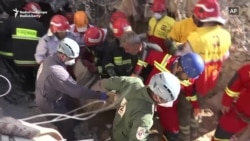Thousands of survivors of a devastating earthquake near the Iran-Iraq border spent another day in bitterly cold temperatures in need of food, water, and other essential supplies.
Iran's Kermanshah Province bore the brunt of the quake, with official media saying on November 14 that at least 530 people died and more than 8,000 others were injured in Iran.
In the more sparsely populated areas across the border in Iraq, officials said at least seven people were killed and more than 530 others injured as a result of the quake. Iraq's Red Crescent put the toll at nine dead.
The 7.3-magnitude earthquake struck about 30 kilometers southwest of the city of Halabja in northeastern Iraq late on November 12.
Iranian state television reported that thousands of survivors spent another night in makeshift camps or out in the open as authorities said several towns and nearly 2,000 villages were damaged.
Photo Gallery: Earthquake Leaves Trail Of Devastation (click to open)
Several villages were said to be completely wiped from the map. The mayor of the city of Ezgeleh said 80 percent of its buildings had collapsed.
About 12,000 residential buildings "totally collapsed," according to an Iran-based Red Crescent official, Mansoureh Bagheri.
Meanwhile, Behnam Saidi, the spokesman for a crisis unit handling the response to the quake, said search operations were "reaching their end."
Iran has so far declined offers of foreign assistance to deal with the aftermath of the tremor, Reuters reported.
As Iran marked a day of mourning, President Hassan Rohani visited the affected region on November 14 and promised that the government would "use all its power to resolve the problems in the shortest time."
Rohani said state-built houses suffered more damage, and those responsible would be held accountable.
"The people should build their own houses. They build better houses than those built under projects and schemes," Rohani said as he visited Kermanshah, state TV reported. "I promise you, those responsible will be punished."
Iranian Supreme Leader Ayatollah Ali Khamenei on November 14 urged state agencies to speed up aid efforts.
Mohammad Ali Jafari, commander of Iran's Islamic Revolutionary Guards Corps (IRGC), said that the immediate needs were tents, water, and food.
"Newly constructed buildings...held up well, but the old houses built with earth were totally destroyed," Jafari said while visiting the region.

The Red Crescent said emergency shelter had been provided for thousands of homeless survivors.
It said many areas lacked water and electricity and that aid supplies were being hampered by roads blocked by landslides.
Ambulances and army helicopters were reported to have joined the rescue effort.
Iran is on many major fault lines and is often hit by damaging earthquakes.
In 2003, a 6.6-magnitude quake destroyed the historic city of Bam, killing 26,000 people.






